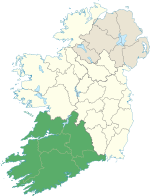Carhoo Hill
Appearance
| Carhoo Hill | |
|---|---|
| Cnoc na Ceathrún | |
 Carhoo Hill from Dingle Harbour | |
| Highest point | |
| Elevation | 184 m (604 ft)[1] |
| Prominence | 169 m (554 ft)[1] |
| Isolation | 4.01 km (2.49 mi) |
| Listing | Marilyn |
| Coordinates | 52°08′23.7″N 10°16′17.5″W / 52.139917°N 10.271528°W |
| Naming | |
| English translation | Hill of the quarter |
| Language of name | Irish |
| Geography | |
| OSI/OSNI grid | V437983 |
| Climbing | |
| First ascent | ancestral |
| Easiest route | hike |
Carhoo Hill or Ballymacadoyle Hill (Irish: Cnoc na Ceathrún, meaning 'Hill of the quarter')[2] is a large hill south-west of Dingle in County Kerry, Ireland.
Geography
The 184-metre (604 ft) high hill stands 4 km west of Dingle in an isolated position in the short peninsula dividing Dingle Harbour from the Atlantic Ocean.
The top of the hill hosts the Eask Tower, a solid stone tower built in 1847.[3] It offers a view on a long stretch of Dingle Peninsula and Iveragh Peninsula.[4]
Name
The English meaning of Cnoc na Ceathrún is hill of the quarter.[5]
Access to the summit
The walk which leads up to the summit takes 1.6 km from the asphalted road. Due the very interesting panorama it's advisable to choose a clear day for it.[3]
See also
References
Wikimedia Commons has media related to Cnoc na Ceathrun.
- ^ a b "Dingle West Area / Carhoo Hill". MountainViews. Ordnance Survey Ireland. Retrieved March 5, 2015.
- ^ "Carhoo Hill [Ballymacadoyle Hill] [Cnoc na Ceathrun]". www.hill-bagging.co.uk. Dublin City University. Retrieved March 5, 2015.
- ^ a b "Eask Tower And Hill". www.discoverireland.ie. Failte Ireland. Retrieved March 5, 2015.
- ^ Christi Daugherty and Jack Jewers (2011). Frommer's Ireland 2011. John Wiley & Sons.
- ^ Patrick Weston Joyce (1870). Vocabulary of Irish Root Words. Retrieved March 5, 2015.


